Health Care > EXAM > West Coast EMT Block 4 Exam Questions and Answers (All)
West Coast EMT Block 4 Exam Questions and Answers
Document Content and Description Below
1st Degree Burn Tissue Effected? Skin Color/Moisture/Appearance? - ANSWER Superficial Thickness (Only Epidermis) Red Skin No Blisters or burns 2nd Degree Burn Tissue Effected? Skin Color/Mois... ture/Appearance? - ANSWER Partial Thickness (epidermis and part of dermis) Not subcutaneous tissue Blistered/white to red/ moist and spotted 3rd Degree Burn Tissue Effected? Skin Color/Moisture/Appearance? - ANSWER Full Thickness All skin layers including subcutaneous and beyond Dry/Leathery/white brown or black hemothorax Bleeding? s/s? Transport? - ANSWER pleural space fills with blood s/s: shock decreased breath sounds on affected side rapid transport Rule of 9's adults Head Chest Arms Abdomen Groin Legs - ANSWER Head - 4.5 Chest - 9 Arms - 4.5 Abdomen - 9 Groin - 1 Legs - 9 (this is per side aka front and back) anaphylaxis (anaphylactic shock) S/s - ANSWER Can develop within seconds, mild itching or rash, burning skin, vascular dilation, generalized edema, coma, rapid death cardiogenic shock S/s Pulse/Resp.'s/Blood Pressure? Skin CMT? Mental Status? Right vs Left - ANSWER P-Either R-Tachy BP-Brady and Narrowing Cool Pale and Clammy/ Cyanotic Anxiety to Decreased AMS JVD/peripheral edema = R. Sided Failure Crackles or rales upon auscultation L. Side fail distributive shock S/s Types of? - ANSWER Anaphylactic/Neurogenic/Septic hypovolemic shock S/s Pulse/Resp.'s/Blood Pressure? Skin CMT? Mental Status? Peripheral Pulse? - ANSWER pulse up / resp.'s up / BP down Pale Cool Clammy Anxiety Decreased Mental Status Weak Peripheral Pulse neurogenic shock S/s - ANSWER Bradycardia, low blood pressure, signs of neck injury Types of Obstructive Shock - ANSWER Cardiac Tamponade, Tension Pneumothorax, Pulmonary Embolism psychogenic shock S/s - ANSWER Rapid pulse, normal or low blood pressure septic shock S/s - ANSWER Warm skin, tachycardia, low blood pressure Pneumothorax - ANSWER accumulation of air in pleural space blood in pleural space will be deoxygenated Open Pneumothorax - ANSWER aka open chest wound or sucking chest wound rapidly sealed with occlusive dressing Spontaneous Pneumothorax - ANSWER Structural Weakness weak area "bleb" can rupture spont sudden unexplained chest pain and shortness of breath Simple Pneumothorax - ANSWER Doesn't result in major changes in pt physio blunt trauma and often accompanies fractured ribs Often worsens and develops complications (tension pneumo) Tension Pneumo - ANSWER Significant air accumulation in pleural space Increased pressure in chest causes: complete collapse of unaffected lung, mediastinum to be pushed into opposite ... commonly caused by stabbings/ blunt injury where fractured ribs lacerate pleural space Ss lacerated aorta - ANSWER High BP in Upper Body Low BP in Lower Body Patho/presentation of chest injury - ANSWER Closed: Heart may not refill or receive blood/Loss of surface area in lung tissue. Rapid and shallow respirations, not moving air Open: Bleeding control - ANSWER External: Direct Pressure/Elevation/Dressing Internal: Splint to suspected area, nothing PO Spinal cord - ANSWER Made of fibers from brain's nerve cells Carries Messages via white and gray matter Paradoxical movement - ANSWER Common in Flail Segments Bilater Vocab - ANSWER Most definitive treatment of _______ means top of top - ANSWER so upto doctor level Subcutaneous emphysema - ANSWER Presence of air in soft tissues Hollow Organs - ANSWER Stomach, Intestines, Bladder, Galbladder if lacerated doesn't bleed much but will leak 1.Acid and 2. Bacteria acid will cause immediate pain bacteria will slowly cause peritonitis Solid Organs - ANSWER Liver, Spleen, Kidney, Pancreas Will leak a lot of blood and cause shock No abdominal pain from leakage Kehr signing from irritated diaphragm Ped immobilization (what to do with head) - ANSWER Have to pad under torso to ensure the head is in the neutralized in line position Lpm for different masks - ANSWER Nasal Cannula = 1-6lpm NRB = 10-15lpm BVM = 15lpm Rigid Splint - ANSWER Hard surface under broken area From Joint above to Joint Below Pad between limb and splint Traction Splint - ANSWER Only for femur if broken in 1 spot and closed fracture Formable Splint - ANSWER Below elbow or knee inflatable air device usually You try to reallign fracture and no pmscs - ANSWER just go Crush Syndrome - ANSWER when area of body is trapped for longer than 4 hours and arterial blood flow is compromised can lead to renal failure and death Blood loss with femur fracture - ANSWER 1 Liter or 1000mL or 1000 cc Impaled eye - ANSWER Doughnut ring gauze place around object over eye secure with gauze Detached retina - ANSWER Retina detaches from the choroid and the sclera and may cause blindness which may be temporary Pericardial tamponade ss - ANSWER Beck's triad AMS support ventilations, position of comfort, rapid transport Beck's triad - ANSWER Low BP/JVD/Distant and muffled heart sounds Immobilizing pt to backboard - ANSWER manual c stabilization/pmsc/collar/roll/backboard/pmsc Commoti cortis - ANSWER Injury caused by sudden direct blow to chest during critical portion of heartbeat may result in immediate cardiac arrest Vfib responds to defibrillation within first 2 minutes of injury How to treat injuries (Laceration, evisceration, flail) - ANSWER Flail: Manage airway, respiratory support, supplemental oxygen, reassess, BULKY DRESSING AND REST PILLOW ON CHEST epidural hematoma - ANSWER blow to head causing linear fracture Rapidly progresses (unconscious to brief conscious to unconscious) pupil on side of injury fixed and dialated arterially fed so bright red Subdural Hematoma - ANSWER fall or strong deceleration is moi commonly outside of brain but inside dura vein fed slurred speech and fluctuating loc Compartment syndrome - ANSWER Swelling in a confined space that produces dangerous pressure; may cut off blood flow or damage sensitive tissue Pain out of proportion to injury auto v object - ANSWER high energy trauma depending on state of car passenger v interior - ANSWER Lower extremity fractures, flail chest, head trauma internal organs v solid structures of body - ANSWER anterior skull bruising and posterior skin damage aka counter/coup frontal collisions - ANSWER abrasion/traction-type injuries on face neck and chest knees injuries to head and chest from steering wheel Rear end collisions - ANSWER Whiplash acceleration ijuries back seat may have injuries to thorax and lumbar Lateral Collisions - ANSWER lateral whiplash lateral chest and abdomen injuries fractures of legs, pelvis, and ribs possible third collision injuries in abdomen injuries to aorta Rollover crashes - ANSWER unrestrained: partial/ejection, strikes within interior of vehicle restrained: spinal cord from hitting the ceiling Rotational Collisions - ANSWER if striking object may have impact injuries Splinter - ANSWER FIGURE IT OUT Phases of blast injuries - ANSWER Primary Blast injury - ANSWER injuries due to blast wave itself (hollow organs most susceptible) Secondary Blast injury - ANSWER injuries due to shrapnell Tertiary Blast injury - ANSWER Injuries due to being thrown What is a ked seated backboard and another name for it - ANSWER short spine or seated backboard My Baby Looks Hot Tonight Layers of skin - ANSWER Epidermis: tough external layer watertight, top layer and germinal layer Dermis: inner below germinal cells, contains hair follicles, sweat glands, and sebacious glands Cushing's triad - ANSWER hypertension/bradycardia/irregular resp pertains to ICP Provide BVM if needed Traumatic asphyxia - ANSWER severe force to chest as evidenced by broken sternum suggest underlying injury to heart Ventilate, oxygen, rapid transport Most critical intervention - ANSWER rapid transport Peritonitis where and ss - ANSWER abdominal cavity inflammation of peritoneum caused by infection from lacerations and spilled contents s/s abdominal pain, tenderness, muscles spasms, nausea and vomiting later turns into bowel stops functioning, distended and firm to touch Cns what it controls and what it's composed of - ANSWER Biggest issue we encounter with open wound - ANSWER infection Perfusion in extremities blood shunted to core - ANSWER Kehr signing - ANSWER patients with liver injury when diaphragm is irritated pain will be felt in the shoulder Presentment of rib facture pts - ANSWER Painful breathing, guarding, self splint give hi flo O2 via NRB Concussion - ANSWER temporary loss or alteration of consciousness 90% aren't +loc ask about dizziness or weakness Symptoms: dazed and confused, lack of coordination Contusion - ANSWER more serious than concussion physical injury to brain tissue long/permanent damage [Show More]
Last updated: 2 years ago
Preview 1 out of 9 pages

Buy this document to get the full access instantly
Instant Download Access after purchase
Buy NowInstant download
We Accept:

Reviews( 0 )
$7.00
Can't find what you want? Try our AI powered Search
Document information
Connected school, study & course
About the document
Uploaded On
Aug 18, 2022
Number of pages
9
Written in
Additional information
This document has been written for:
Uploaded
Aug 18, 2022
Downloads
0
Views
165
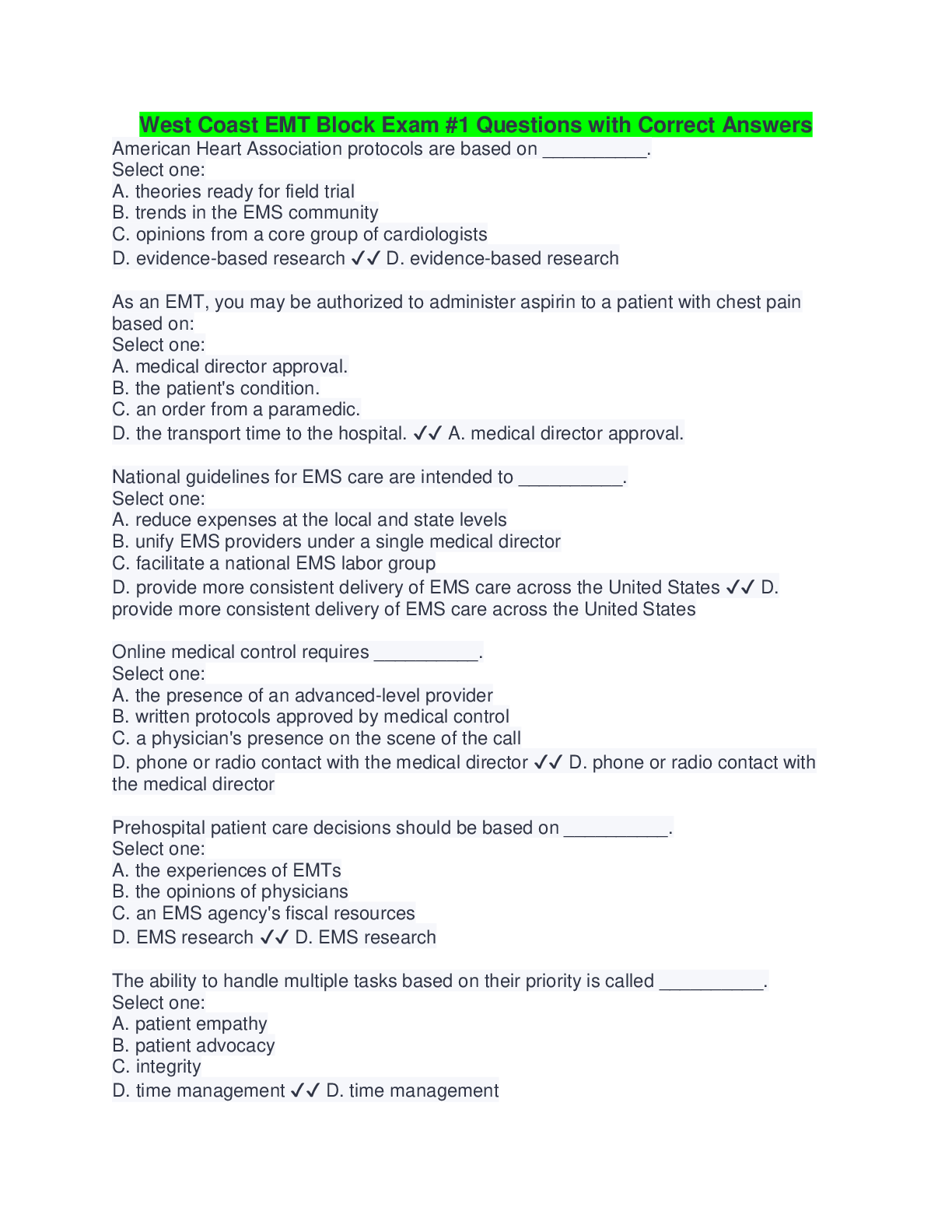



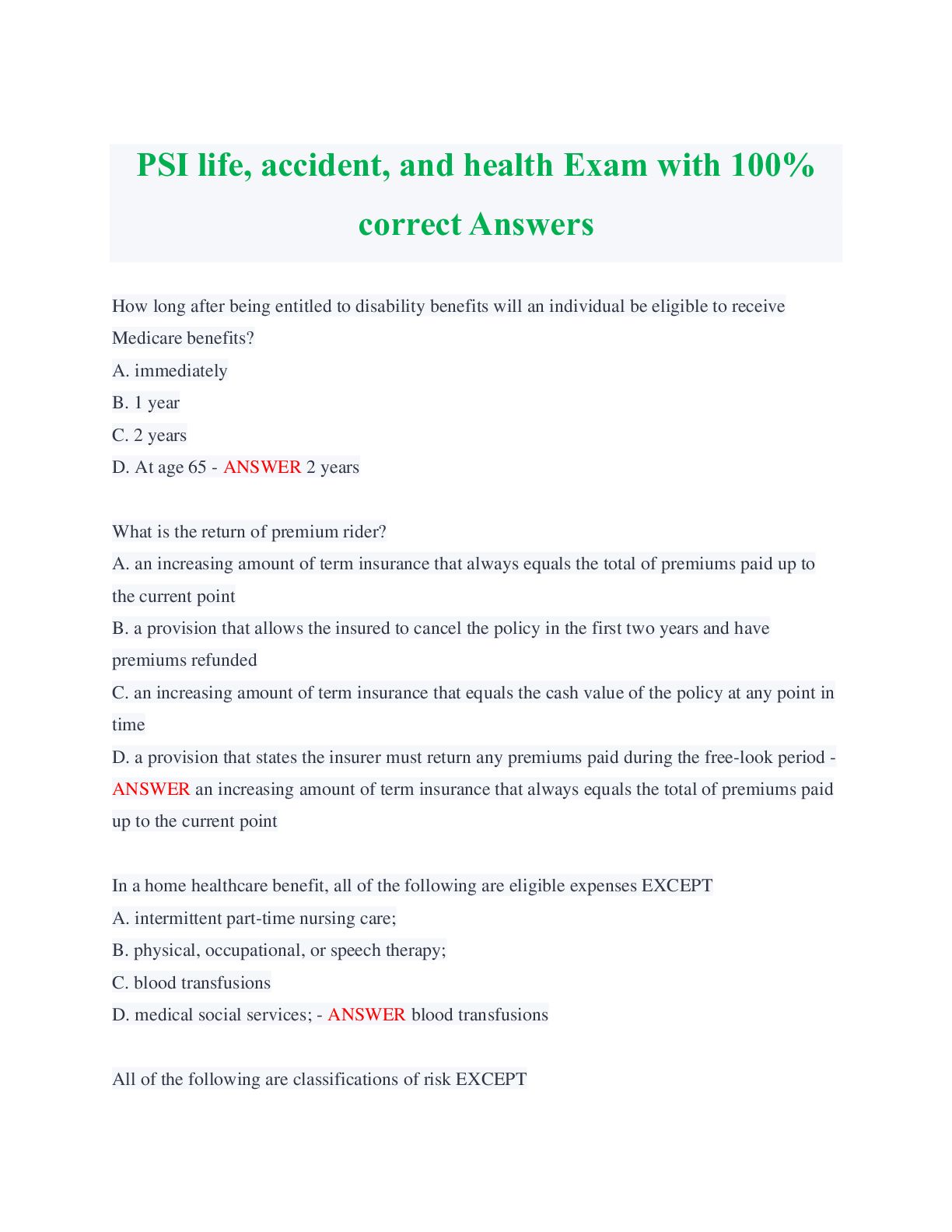















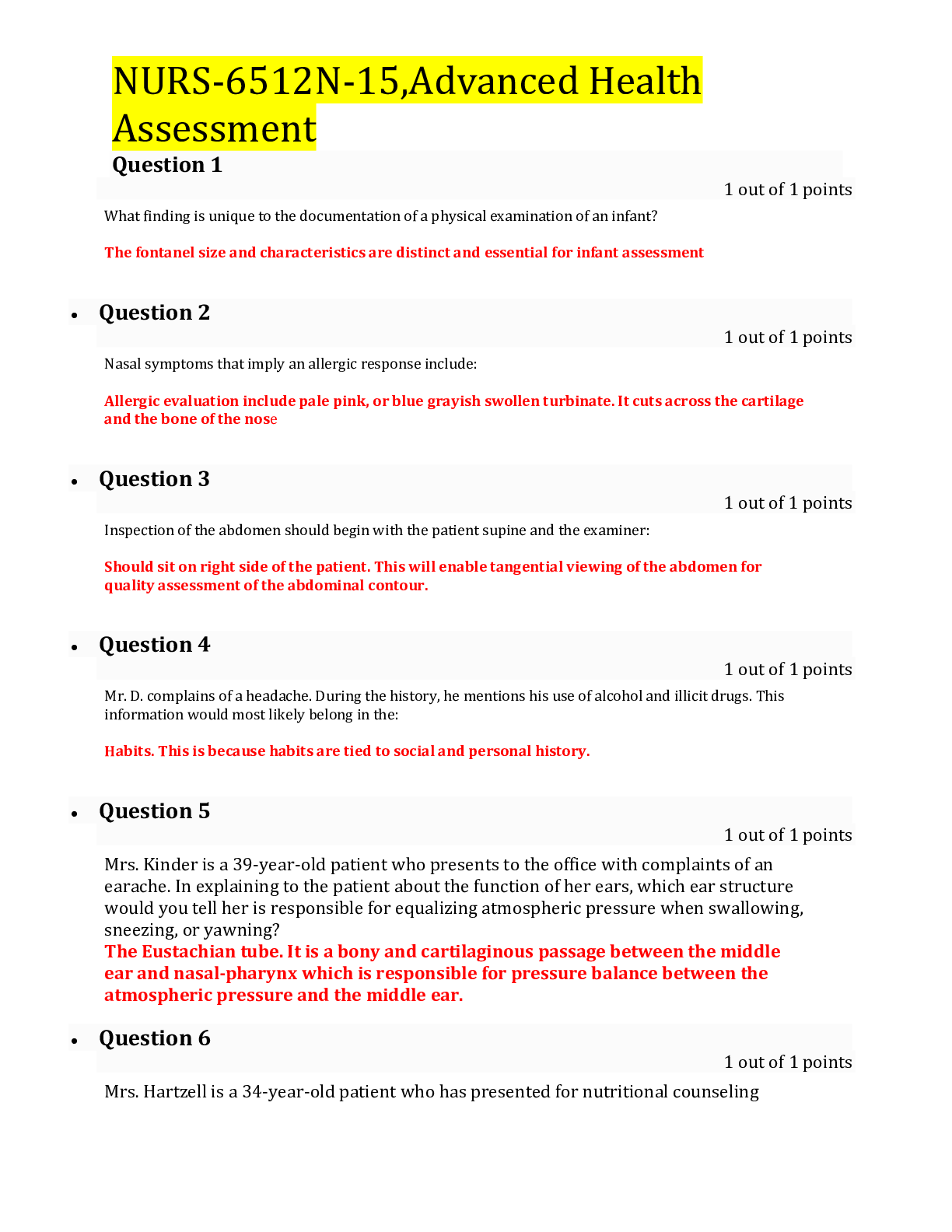
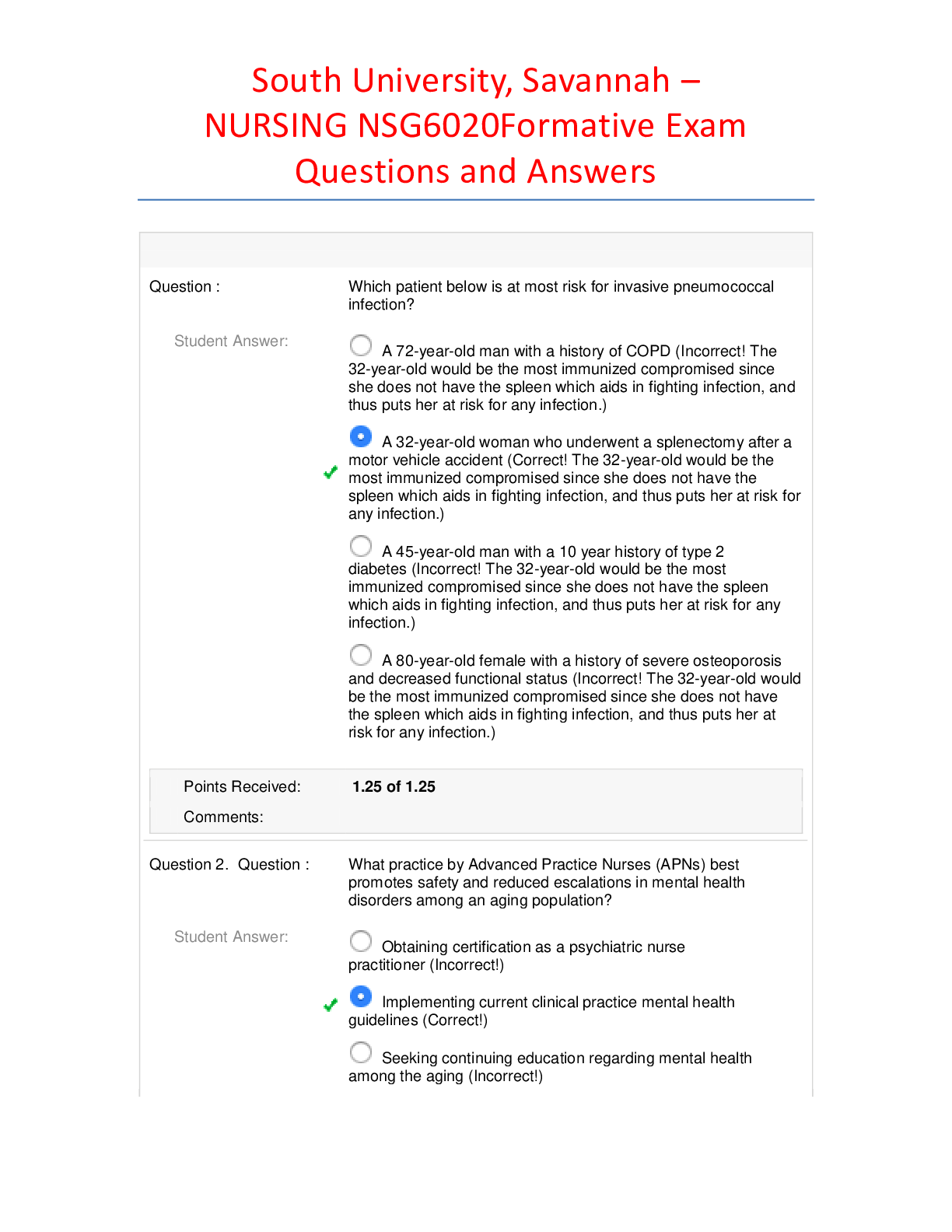


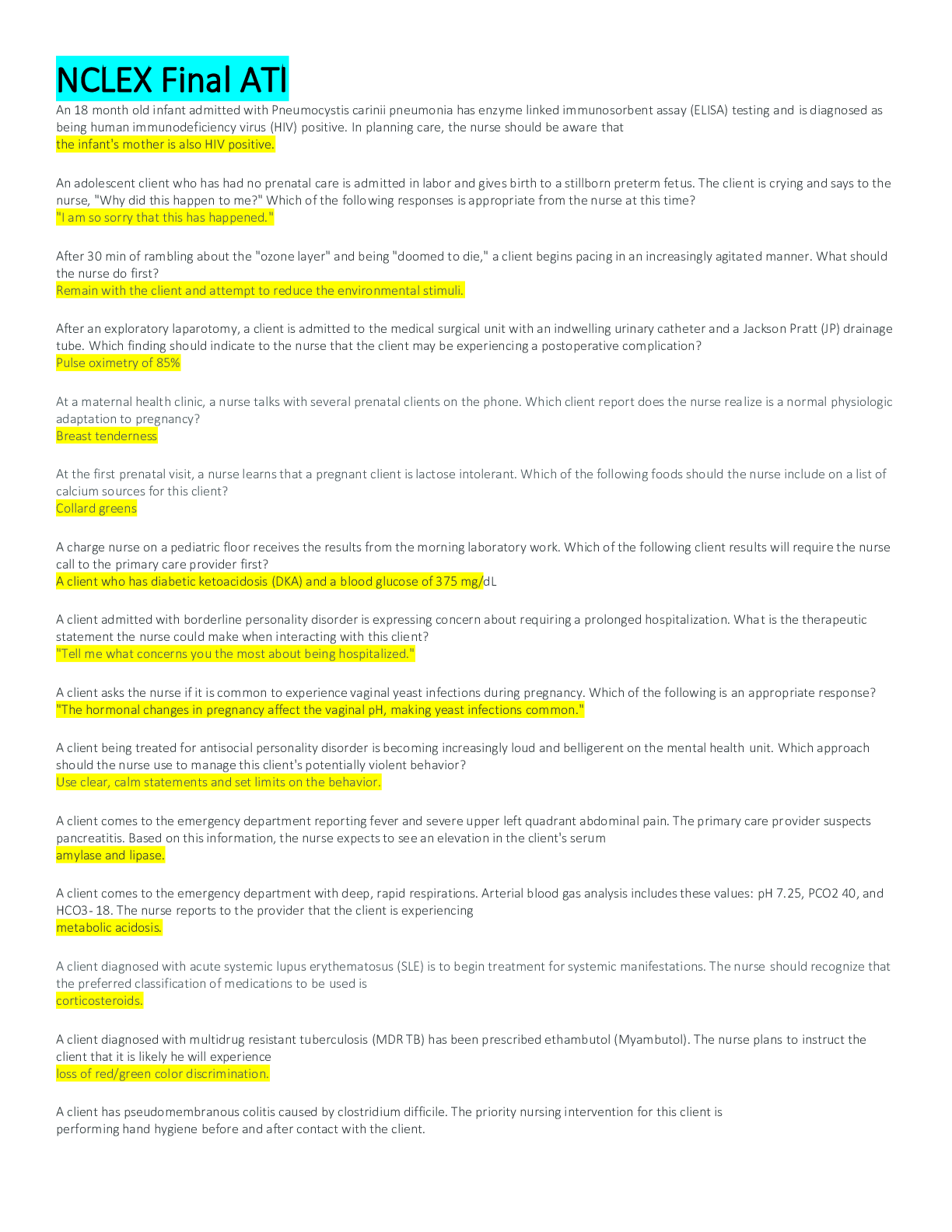
.png)

